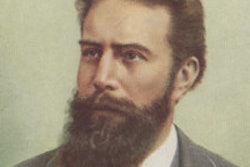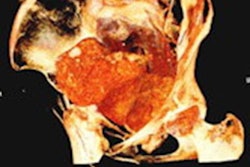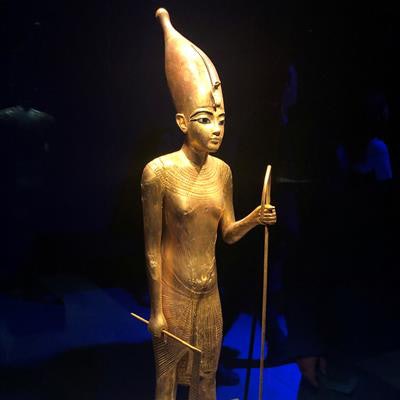
The main risks to radiologists have traditionally been related to three causes: overexposure to radiation, electrical accidents, and hazards associated with the chemicals used in film processing. Being cursed by a mummy would not come particularly high up on the list of dangers for most of us, but this was the reputed fate of Sir Archibald Douglas Reid (1871-1924), who was a radiologist at St. Thomas' Hospital in London.
The sensation of the 1920s was the discovery of the undisturbed tomb of the boy pharaoh Tutankhamun on 4 November 1922 by the Egyptologist Howard Carter, who was backed by Lord Carnarvon, the 5th Earl. The excavation and cataloging should have been straightforward, although time-consuming, but there were to be unexpected difficulties.
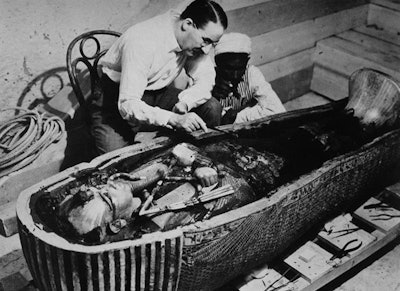 Howard Carter and an Egyptian workman examining the third coffin of Tutankhamun made of solid gold (1925). All images courtesy of Dr. Adrian Thomas.
Howard Carter and an Egyptian workman examining the third coffin of Tutankhamun made of solid gold (1925). All images courtesy of Dr. Adrian Thomas.Carnarvon was staying in Aswan and was, unfortunately, bitten by a mosquito. The bite became septic, and Carnarvon, in a weakened state, developed pneumonia. In March 1923, Marie Corelli had written about the risks of breaking into a royal tomb and looting the contents, stating that punishments would ensue. Carter recounted seeing a strange animal at the entrance of the tomb that looked like a jackal and resembled Anubis, the god of death and the afterlife.
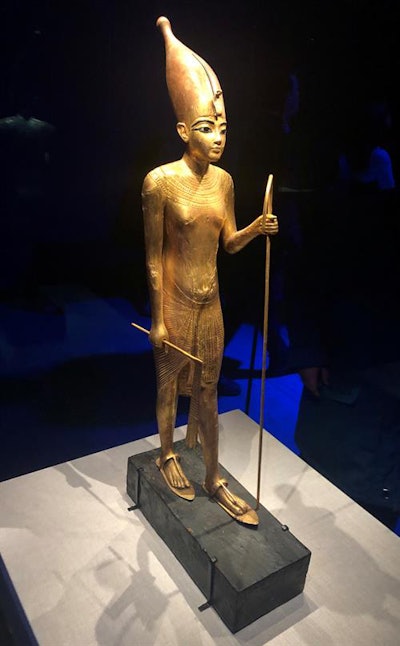 Wooden statue of the King in the White Crown. The king is making his way through the underworld (photography by Dr. Adrian Thomas).
Wooden statue of the King in the White Crown. The king is making his way through the underworld (photography by Dr. Adrian Thomas).Carnarvon had apparently laughed and made jokes as he entered the tomb, and the Egyptologist Arthur Weigall had foretold his death before six weeks would pass. Sure enough, Carnarvon was dead within a month and a half, dying on 5 April 1923 at the Continental-Savoy Hotel in Cairo. The mosquito is said to have bitten Carnarvon in the same location as a wound on the cheek of Tutankhamun, and when Carnarvon died, a favorite dog howled and died at his home in Highclere Castle in England.
Highclere Castle has recently been used for filming of the TV and movie period drama "Downton Abbey." The 8th Earl and Countess of Carnarvon have opened an Egyptian exhibition in the cellars of Highclere to celebrate the 5th Earl's achievements.
As time went by, the curse accumulated an increasing number of victims. The victims had either visited the tomb or were associated with the excavation. Some deaths may be coincidental, but some are more difficult to explain. Two of Carnarvon's half-brothers died, and shortly after visiting the tomb in July 1923, Prince Ali Kamel Fahmy Bey was shot dead by his wife. More recently, the head of the Antiquities Service was killed in a road accident shortly after signing the contract for the 1970s traveling exhibition "Treasures of Tutankhamun."
Early use of x-ray
X-rays were used in Egyptology shortly after they were discovered in 1895. Radiology allows mummies to be examined without having to take them apart, which is a destructive process. As radiology has developed, new imaging techniques have been applied to archaeology.
Carter had hoped to examine the body with x-rays and had therefore invited Reid to Egypt. Reid was particularly interested in diagnostic radiology and was ideally placed to examine the boy king, but like so many of the pioneers, he had developed radiation dermatitis of the fingers. His general health had deteriorated over the years, and he went to Chur in Switzerland in the hope that the mountain air would help him. Sadly, his condition deteriorated, and he died following abdominal surgery at the age of 53 in early 1924. Reid seemed to be another victim of the curse before he could even go to Egypt.
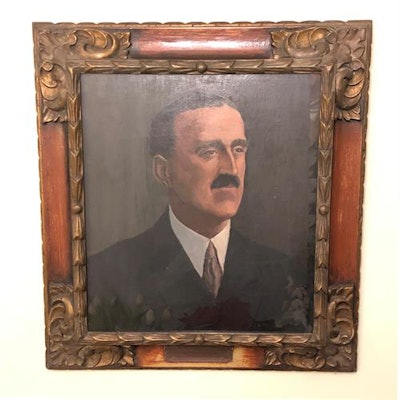 Sir Archibald Douglas Reid, painted by Maj. Charles E. S. Philips (collection of Dr. Adrian Thomas).
Sir Archibald Douglas Reid, painted by Maj. Charles E. S. Philips (collection of Dr. Adrian Thomas).There had already been some damage to the mummy because the body was fixed within the sarcophagus by the resins that were used in the embalming process. There had been some damage when the body was freed, and the king, of necessity, had to be cut into several pieces. The arms and legs were severed, and the head with the beautiful golden mask still attached was removed. To hide the damage, Carter placed the body on sand in a wooden tray and used resin to piece the body together. The photographs taken by Harry Burton therefore never showed the extent of the damage caused by Carter.
Little of significance happened until 1968 when the body was examined by the Edinburgh anatomist R. G. Harrison using an old portable x-ray machine. This was the first radiological examination of Tutankhamun and, although not all of Harrison's conclusions were correct, he did reveal the extent of the damage. Harrison's work was reviewed by Richard Boyer and others in an interesting paper in 2003 that is worth reading (American Journal of Neuroradiology, June 2003, Vol. 24:6, pp. 1142-1147).
London exhibition
The current exhibition, "Tutankhamun: Treasures of the Golden Pharaoh," at the Saatchi Gallery celebrates the centenary of Carter's discovery and is open in London until 3 May 2020. The exhibition was previously in Los Angeles and Paris. At the inauguration of the exhibition at the Saatchi Gallery, Zahi Hawass predicted that the London show might well raise $10 million for Cairo's Grand Egyptian Museum, which is nearing completion and could open next year. Other locations for the Tutankhamun tour include the Australian Museum in Sydney, as well as venues in Japan, Canada, and South Korea.
So, was Archibald Reid a victim of the curse of Tutankhamun, or did he succumb to deteriorating health in part related to radiation exposure? Did Howard Carter suffer from the curse? Probably not, since Carter died some considerable time afterward in London on 2 March 1939, at age 64, from Hodgkin's disease. If anyone deserved to feel the effects of the curse, it's Carter, who damaged the body and tried to take the treasures out of the country, only being stopped by legal action in Egypt. He should, however, be thanked for bringing the boy king back into the world.
Will I suffer the curse, having visited the Saatchi Gallery? I hope not. What do you think?
Dr. Adrian Thomas is chairman of the International Society for the History of Radiology and honorary librarian at the British Institute of Radiology.
The comments and observations expressed herein do not necessarily reflect the opinions of AuntMinnieEurope.com, nor should they be construed as an endorsement or admonishment of any particular vendor, analyst, industry consultant, or consulting group.





